One State, but Two Economies
The economic activity decreased in Coos County in winter 2015. The County Index fell for the fourth consecutive quarter on a year-over-year basis. The pace of declines accelerated during the same period. The goods-producing sector weakened further; industrial electricity sales marked a double-digit decline compared to the same period a year ago. The broad economy faltered; both number of employed residents and wages and salaries decreased from prior year. On a positive note, more travelers came to the region and spent more; average Saturday vehicle traffic counts increased six consecutive quarters while spending at lodgings rose for the eighth straight quarter. The County’s housing market saw a sign of stabilization; although median home prices fell four consecutive quarters on a quarterly year-over-year basis, the volume of home sales rebounded and was up from winter 2014.
While the County Index declined further, the State Index inched closer to the pre-recession level. Four out of the five component indicators either exceeded or nearly reached the pre-recession level, an index of 100. The BLS’s revised employment data showed encouraging signs; the pace of increases in the number of employed residents accelerated two straight quarters. The tourism sector remained strong; both the average Saturday vehicle traffic counts and spending at lodgings were up from the same period a year earlier. The state’s housing market data painted a mixed picture; the volume of home sales rebounded and rose from the winter 2014 level, while the pace of increases in median home prices continued to slow down. Three of the four state leading indicators remained up; number of building permits was down three straight months.
Student Report by Sean McGlynn
Having grown up in the north country, Khristine Boucher is no stranger to the plenitude of recreational opportunities that Coös County has to offer to residents and visitors alike. After graduating from Champlain College Khris moved away from the area for a number of years. “It was a long stretch before I was able to move back home,” say Khris. “Even in a specialized field like radiology, it was hard to find employment. We need to try and create growth in the area.”
With paper mills and manufacturing providing a fraction of the jobs they once did, Khris believes that tourism will be an important aspect in the future of the north country. “As the paper industry has come to a curtail, I think that tourism is the direction we’re really going to need to take,” says Khris.
Along with her husband Jameson, Khris has decided to join the growing number of tourism business owners in the area, with the recent purchase and opening of Deer Mountain Lodge in Dummer. The lodge is situated off of Route 16 on 47 acres of land. The lot has easy access to the Ride the Wilds ATV and snowmobile trails, as well as trail access to the Androscoggin River. The newly renovated lodge offers all the expected modern day comforts, including high speed internet, to go along with the natural beauty and remote setting that people visit the North Country for.
Having the support of the community is essential for a small business, and that seems to be something Deer Mountain Lodge will not have to worry about. “Just since our opening we have been bombarded with messages from local guide services, rafting companies and others wanting to partner and work with us. We have been taken aback by the amount of positive response.” A lack of lodging has been a cited structural weakness hindering visitation, so the lodge is a more than welcome addition. “The local guide services and rafting companies are so excited to have a place that can offer upscale lodging to their customers,” say Khris.
The lodge is 6,000 square feet and will eventually have 9 bedrooms and will be able to host 30 people. Khris and Jameson also have plans to offer campsites and small cabins in the future. “We hope to offer longer term accommodations and even a place where people can store their ATVs.The master plan includes hosting barn weddings and functions as well. I can see us growing and needing a small staff eventually.” This vision for the future, with consideration for both current market needs and the environment, is something every community could use more of.
For more information on Deer Mountain Lodge visit their website at www.deermountainlodge.com or visit them on Facebook at https://www.facebook.com/deermountainlodge/timeline.
Coincident Index
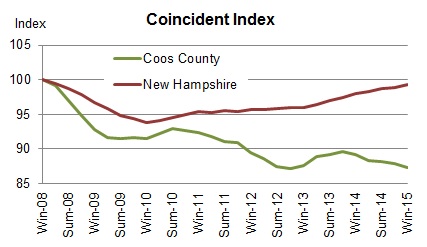
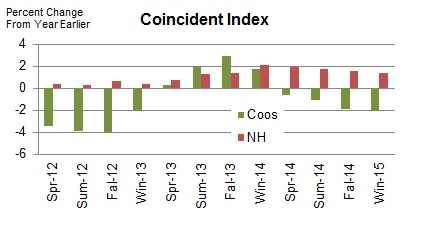 The Coos Coincident Index, which tracks the current state of the Coos economy, fell to 87.3 in Winter 2015 from Summer’s revised value of 87.9. On a quarterly year-over-year basis, the Index decreased for the fourth quarter in a row.
The Coos Coincident Index, which tracks the current state of the Coos economy, fell to 87.3 in Winter 2015 from Summer’s revised value of 87.9. On a quarterly year-over-year basis, the Index decreased for the fourth quarter in a row.
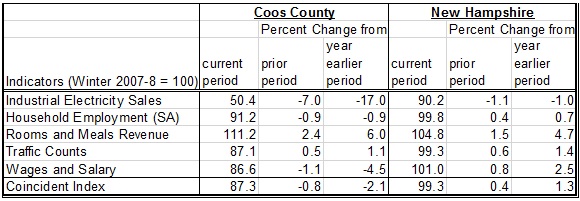 The New Hampshire Coincident Index inched up to 99.3 in Winter 2015 from Summer’s revised value of 98.9. On a quarterly year-over-year basis, the index increased for the 18th consecutive quarters.
The New Hampshire Coincident Index inched up to 99.3 in Winter 2015 from Summer’s revised value of 98.9. On a quarterly year-over-year basis, the index increased for the 18th consecutive quarters.
How strong are the forces of change?
In Winter 2015, the Coos Coincident Index decreased four straight quarters on a quarterly year-over-year basis. The pace of declines accelerated during this period. Three of the five component indicators turned down from their Winter 2014 levels. The State Index increased for the 18th quarter in a row on a quarterly year-over-year basis. Four out of the five component indicators remained up from a year ago. The pace of growth fell four quarters in a row.
Household Employment
Household employment measures the number of employed residents. In contrast to non-farm payroll employment that is more commonly used in the national and state indexes, household employment includes self-employed, unpaid domestic help and both farm and non-farm workers, all of which may be more significant in rural than urban economy. Employment tends to rise as economy grows.
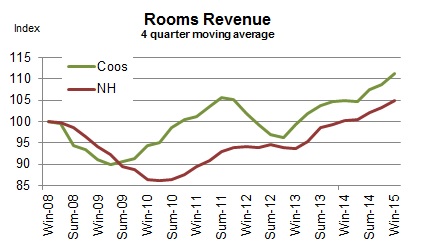 Rooms Revenue
Rooms Revenue
Rooms revenue represents spending on accommodations paid by travelers. It’s a good hospitality sector’s indicator in the sense that it’s not an estimate, but an official count as reported by the New Hampshire Department of Revenue Administration. However, it may not fully reflect changes in the overall activity level in the hospitality sector. Although it tracks a majority of overnight travelers, it excludes day travelers and overnight travelers staying with friends and family and those who have second homes. In the case of the northern regions of the state, the effect of the drawback is less of a concern since day travelers are a small minority due to the distance from the major urban areas.
Traffic Counts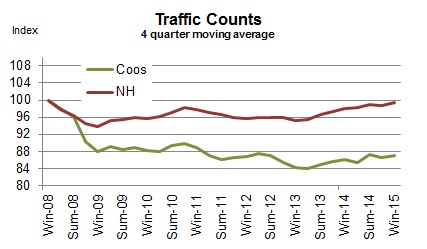
It tracks the average vehicle traffic counts on Saturdays each quarter, which is automatically collected from traffic recorders located throughout the State. 12 recorders are selected to reflect traveler traffic in each of the seven travel regions in the State with two recorders from Coos County – Jefferson and Northumberland.
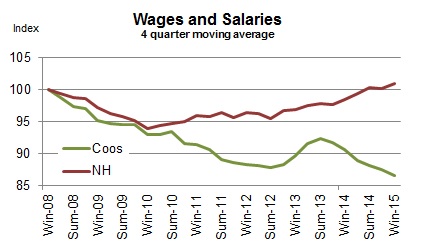 Wages and Salaries
Wages and Salaries
The estimated wage and salaries disbursements represent total compensation including pay for vacation, bonuses, stock options, and tips. This data is obtained from all workers covered under state and federal unemployment insurance laws; in other words, it is full population counts, not sample-based estimates. Unlike the household employment report, however, it excludes self-employed, domestic workers, and most agricultural workers. For this difference, wages and salaries series complements the number of employed residents in monitoring the labor market conditions as well as the economy. A change in wages and salaries, adjusted for inflation, may reflect changes in the number of jobs, the ratio between part-time and full-time jobs, and wage rates.
Industrial Electricity Sales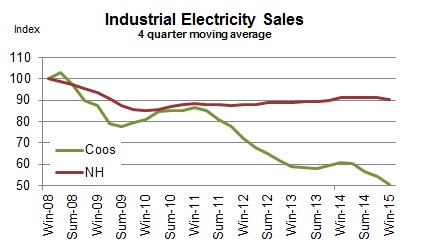
It measures sales of electricity (kWh) to industrial customers. Utilities categorize consumers based on the North American Industry Classification System, demand, or usages. The industrial sector includes manufacturing, construction, mining, agriculture, fishing, and forestry establishments. Among these industries, manufacturing is a primary industry in Coos County making up 69% (73% for New Hampshire in 2008) of the total number of jobs in the industrial sector mentioned above according to the 2006 QCEW data. Therefore, a rise in industrial electricity sales may largely indicate invigorating manufacturing activities in the economy.
Real Estate
NCEI reports two real estate market indicators – home sales and median home prices. The data tracks residential homes sold, including condos and manufactured homes. The health of the real estate sector is important to the broad economy due to its multiplier effect. Home transactions not only generate income for real estate brokers and mortgage bankers but also bring more businesses in other sectors including moving services, home furnishings and appliances. In order to minimize volatility in Coos real estate market, indicators are averaged over a four quarter period.
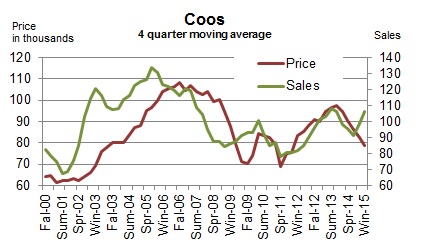 Coos County
Coos County
In winter 2015, the declining county’s housing market showed signs of stabilization. The volume of home sales, smoothed by four quarter moving average, rose on a year-over-year basis after decreasing four quarters in a row. The median home price, smoothed by four quarter moving average, decreased for the fourth straight quarter on a year-over-year basis.
New Hampshire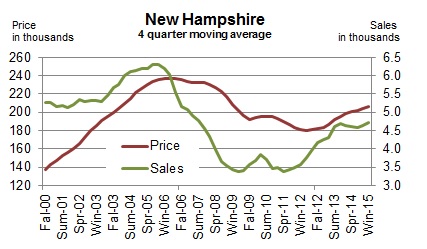
The volume of home sales, smoothed by the four-quarter moving average, increased on a year-over-year basis after decreasing two consecutive quarters. The pace of increases in median home prices, smoothed by four quarter moving average, decreased for the fourth consecutive quarter.
Leading Indicators
Leading indicators are to provide a sense of future economic conditions in the state of New Hampshire. The report includes six leading indicators grouped into three different categories – 1) four leading indicators for the broad economy of New Hampshire; 2) a leading indicator of the state’s tourism industry; 3) a leading indicator of the U.S. economy. The list of leading indicators for New Hampshire’s economy includes initial unemployment claims, average weekly hours of work in the total private sector, building permits, and new business formation; the state’s tourism industry has the Massachusetts Leading Index published by the Philadelphia Federal Reserve Bank; the report also includes interest rate spread between 10-year Treasury and federal funds for the U.S. economy. Although the list is by no means exhaustive and indicators often do not go back long enough in time for statistically robust analysis, we believe it can still be a helpful tool. Raw data are processed so as to make it easier to detect a change in the direction of the underlying trend in the economy. In the summary table below, “up” during recession indicates recovery around the corner while “down” during an expansion signals an impending recession. During expansion, the likelihood of recession increases when more indicators turn down persistently. For example, all four leading indicators of NH economy start posting “down” month after month at the beginning of the state’s 2008 recession. The New Hampshire recessions are defined as the period of declines in the New Hampshire Coincident Index published by the Philadelphia Federal Reserve Bank.
In February 2015, three of the four New Hampshire leading indicators were up compared to six months ago in their year-over-year growth rate.
 *This series is inverted so that an “up” means an improvement. Layoffs decrease (inverted layoff increases) when the labor market conditions improve.
*This series is inverted so that an “up” means an improvement. Layoffs decrease (inverted layoff increases) when the labor market conditions improve.
**”Up” or “down” is a change in the spread from prior month.
***”Up” or “down” is a change in the Index from six month ago. MA Leading Index is currently not available while the Philadelphia Federal Reserve Bank is revising the data.
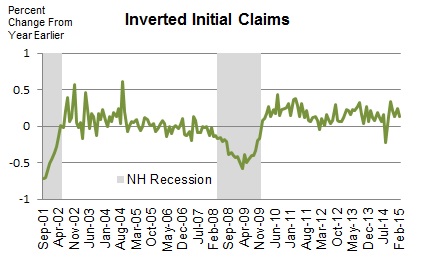 Initial Unemployment Claims
Initial Unemployment Claims
The series is inverted so that an increase means an improvement. Initial claims decrease (inverted initial claims increase) when the labor market condition improves. The number of Initial claims tends to lead the business cycle. The chart demonstrates that it correctly predicted both the beginning and the ending of the past two recessions.
Average Weekly Hours of Work in Private Sector
It tends to turn before the economy does because employers often increase work hours of existing workers at the beginning of the recovery before committing to new hires; they do not want to take the risk of committing to new hires and seeing the economy fall back again. This data for New Hampshire only goes back to 2007.
 New Business Formation
New Business Formation
All companies that want to do business in the state must register at the NH Secretary of State. This data includes all types of businesses including corporations and limited liabilities companies. The number of new businesses tends to lead the business cycle. Although this series goes back only to 2006, it correctly predicted the beginning and ending of the state’s 2008 recession. The series is smoothed by 12 month moving average.
Building Permits for Single Family Homes
It’s often the case housing recovery leads the broad economy out of recession. This is because of its extensive ripple effect over the rest of the economy. Building construction requires inputs from many other industries such as window manufacturing, logging, plumbing, electricity services, banking, and home furnishings such as consumer electronics and furniture. The 2001 recession was a mild recession and a rare one that did not involve a housing slump. The series is smoothed by four month moving average.
Interest Rate Spread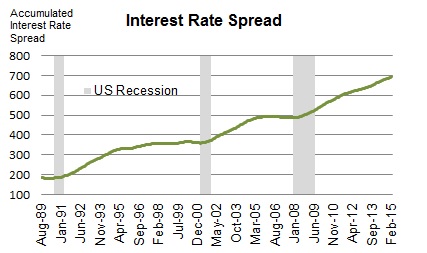
The interest rate spread, the 10 year Treasury less the Federal Funds, is considered one of the best leading indicators for the national economy. The indicator is the sum of all the past values plus the spread in the current period. Therefore, it decreases when the current spread is negative (the 10 year T rate is lower than the Fed Funds Rate), which is indicative of an impending recession.
Massachusetts Leading Index
The state of Massachusetts economy is critical for the New Hampshire’s tourism industry, since the largest share of visitors to New Hampshire come from Massachusetts. Therefore, the Massachusetts Leading Index may also shed light on the future performance of the New Hampshire’s tourism industry. The MA Leading Index is published by the Philadelphia Federal Reserve Bank. A New Hampshire tourism recession was defined as a period of declines in the year-over-year growth of real spending at lodgings.
Technical Notes
- Employment is the number of people employed from the household survey.
- The current values of rooms and meals revenues are estimated using the data obtained from participating local hoteliers.
- The data series reported in the dollar values are adjusted for inflation.
- Real Estate data is obtained from the Northern New England Real Estate Network (NNEREN). All analysis and commentary related to the statistics is that of the authors, and not that of NNEREN.
© Copyright 2010: Daniel Lee and Vedran Lelas, College of Business Administration, Plymouth State University.
